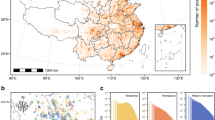Abstract
Human trajectories provide spatial information on how citizens interact with the city. This information can explain the daily routine, economic and cultural cycle of citizens. In the last year, the pattern of human trajectories is expected to change over cities due to Covid-19. This paper investigates the change in human trajectories based on the social media data (SMD) before and after the Covid-19. This study aims to find out the differences between the years 2018, 2020, and 2021. Firstly, all accounts for each year are classified based on movement behaviors. Secondly, spatial distributions of the tweets in terms of classified accounts are visualized after the hierarchical clustering applied to each dataset. Lastly, the average step lengths (ASL) are calculated for each account and classified in terms of step length levels as no movement, neighborhood, district, inter-districts, inter periphery, and center, outbound. The number of tweets and distinct accounts decreased by 90% and 84% from 2018 to 2021. The decrease in the number of single tweeting accounts is 84%, it is 60% in stationary accounts, and 94% in moving ac-counts. The size of the spatial clusters also decreased for all types of accounts maps, however, some of the previously visited spatial points are disappeared while new ones appeared on maps of single tweeting and moving accounts. The ASL of moving accounts also confirms the human movement decrease. According to that, the max, mean, and median ASL decreased 22%, 13%, and 35%. Results point out outcomes vary in terms of accounts’ movement behaviors. This study is expected to contribute the measuring the pandemic impacts on human movement with SMD.
Access this chapter
Tax calculation will be finalised at checkout
Purchases are for personal use only
Similar content being viewed by others
References
Ahas, R., et al.: Everyday space–time geographies: using mobile phone-based sensor data to monitor urban activity in Harbin, Paris, and Tallinn. Int. J. Geogr. Inf. Sci. 29(11), 2017–2039 (2015)
Huang, Q., Wong, D.W.: Activity patterns, socioeconomic status and urban spatial structure: what can social media data tell us? Int. J. Geogr. Inf. Sci. 30(9), 1873–1898 (2016)
Noulas, A., Scellato, S., Lambiotte, R., Pontil, M., Mascolo, C.: A tale of many cities: universal patterns in human urban mobility. PloS ONE 7(5), e37027 (2012)
Buchin, K., Löffler, M., Popov, A., Roeloffzen, M.: Fréchet distance between uncertain trajectories: computing expected value and upper bound. In: 36th European Workshop on Computational Geometry (EuroCG 2020). Würzburg, Germany (2020)
Dodge, S., Gao, S., Tomko, M., Weibel, R.: Progress in computational movement analysis–towards movement data science (2020)
Zheng, Y.: Trajectory data mining: an overview. ACM Trans. Intell. Syst. Technol. (TIST) 6(3), 1–41 (2015)
Buchin, K.: Trajectory Similarity. Winter School on Computational Geometry AUT, 11th Winter School on Computational Geometry. https://www.youtube.com/watch?v=GqOIzUEZgsA&list=LL&index=17. Accessed 03 May 2021
Jurdak, R., Zhao, K., Liu, J., AbouJaoude, M., Cameron, M., Newth, D.: Understanding human mobility from Twitter. PloS ONE 10(7), e0131469 (2015)
Demšar, U., Long, J.A., Siła-Nowicka, K.: Integrated science of movement. J. Spat. Inf. Sci. 2020(21), 25–31 (2020)
Minghini, M., Coetzee, S., Grinberger, A.Y., Yeboah, G., Juhász, L., Mooney, P.: OpenStreetMap research in the COVID-19 era. Editors 1 (2020)
Ma, D., Osaragi, T., Oki, T., Jiang, B.: Exploring the heterogeneity of human urban movements using geo-tagged tweets. Int. J. Geogr. Inf. Sci. 34(12), 2475–2496 (2020)
Xin, Y., MacEachren, A.M.: Characterizing traveling fans: a workflow for event-oriented travel pattern analysis using Twitter data. Int. J. Geogr. Inf. Sci. 34(12), 2497–2516 (2020)
Gabrielli, L., Rinzivillo, S., Ronzano, F., Villatoro, D.: From tweets to semantic trajectories: mining anomalous urban mobility patterns. In: Nin, J., Villatoro, D. (eds.) CitiSens 2013. LNCS, vol. 8313, pp. 26–35. Springer, Cham (2013). https://doi.org/10.1007/978-3-319-04178-0_3
McKenzie, G., Janowicz, K., Gao, S., Gong, L.: How where is when? On the regional variability and resolution of geosocial temporal signatures for points of interest. Comput. Environ. Urban Syst. 54, 336–346 (2015)
Kumari, A., Behera, R.K., Shukla, A.S., Sahoo, S.P., Misra, S., Rath, S.K.: Quantifying influential communities in granular social networks using fuzzy theory. In: Gervasi, O., et al. (eds.) ICCSA 2020. LNCS, vol. 12252, pp. 906–917. Springer, Cham (2020). https://doi.org/10.1007/978-3-030-58811-3_64
Behera, R.K., Jena, M., Rath, S.K., Misra, S.: Co-LSTM: convolutional LSTM model for sentiment analysis in social big data. Inf. Process. Manag. 58(1), (2021)
Slös Wogu, I.A.P., Njie, S.N.N., Katende, J.O., Ukagba, G.U., Edogiawerie, M.O., Misra, S.: The social media, politics of disinformation in established hegemonies, and the role of technological innovations in 21st century elections: the road map to us 2020 presidential elections. Int. J. Electron. Gov. Res. (IJEGR) 16(3), 65–84 (2020)
Hijmans, R.J.: Introduction to the “geosphere” package (Version 1.5-10) (2019)
R Core Team: R: A language and environment for statistical computing. R Foundation for Statistical Computing, Vienna, Austria (2020)
Bivand, V.R., Rundel, C.: rgeos: Interface to Geometry Engine - Open Source (‘GEOS’). R package version (2020)
Tennekes, M.: tmap: Thematic maps in R. J. Stat. Softw. 84(6), 1–39 (2018)
Michelot, T., Langrock, R., Patterson, T.A.: moveHMM: an R package for the statistical modelling of animal movement data using hidden Markov models. Methods Ecol. Evol. 7(11), 1308–1315 (2016)
Snow, J.: On the Mode of Communication of Cholera. John Churchill (1855)
Gulnerman, A.G., Karaman, H., Pekaslan, D., Bilgi, S.: Citizens’ spatial footprint on Twitter—anomaly, trend and bias investigation in Istanbul. ISPRS Int. J. Geo Inf. 9(4), 222 (2020)
Gulnerman, A.G., Karaman, H.: Spatial reliability assessment of social media mining techniques with regard to disaster domain-based filtering. ISPRS Int. J. Geo Inf. 9(4), 245 (2020)
Author information
Authors and Affiliations
Corresponding author
Editor information
Editors and Affiliations
Rights and permissions
Copyright information
© 2021 Springer Nature Switzerland AG
About this paper
Cite this paper
Gulnerman, A.G. (2021). Changing Pattern of Human Movements in Istanbul During Covid-19. In: Gervasi, O., et al. Computational Science and Its Applications – ICCSA 2021. ICCSA 2021. Lecture Notes in Computer Science(), vol 12957. Springer, Cham. https://doi.org/10.1007/978-3-030-87013-3_17
Download citation
DOI: https://doi.org/10.1007/978-3-030-87013-3_17
Published:
Publisher Name: Springer, Cham
Print ISBN: 978-3-030-87012-6
Online ISBN: 978-3-030-87013-3
eBook Packages: Computer ScienceComputer Science (R0)




